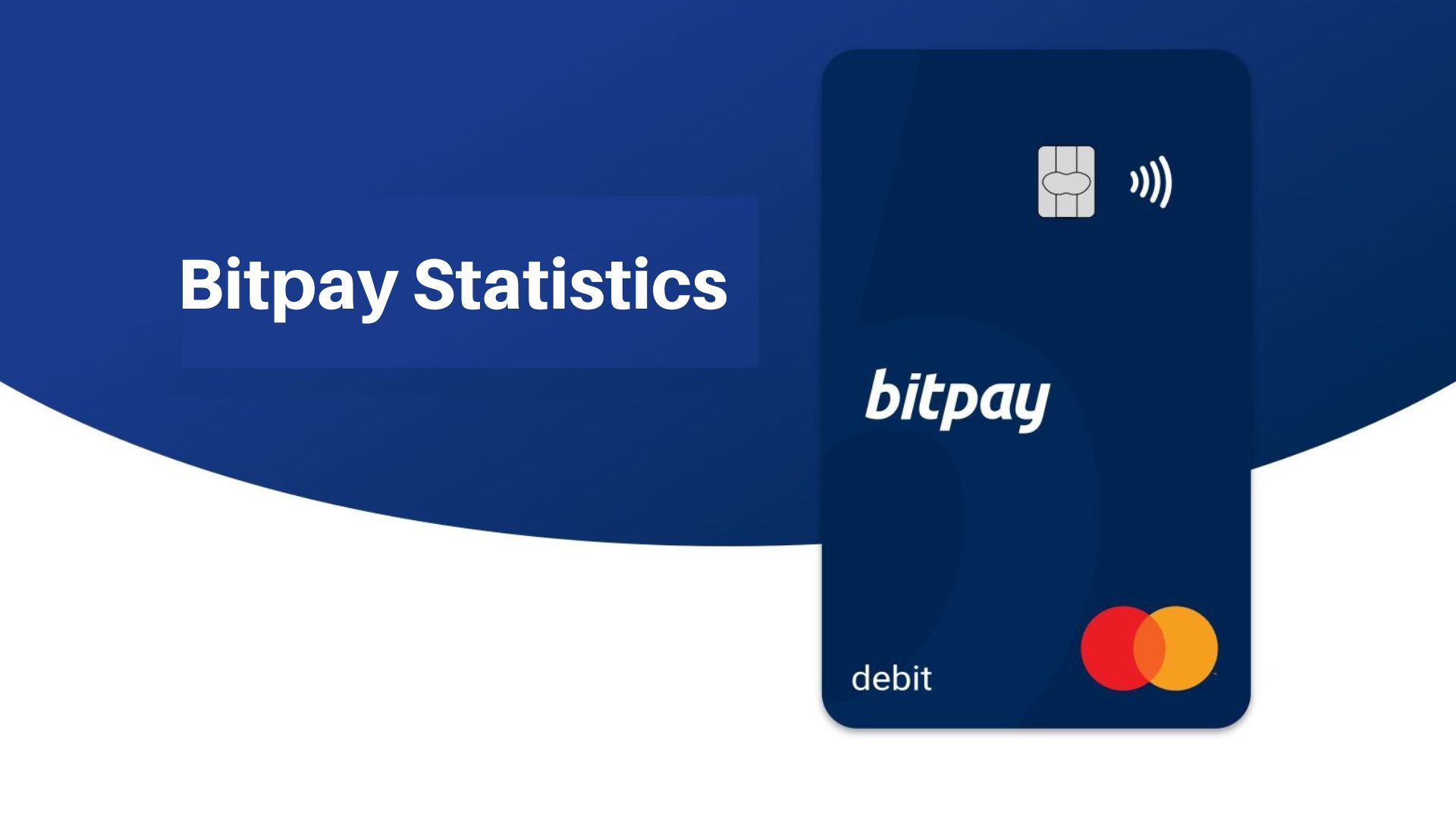Blockchain Statistics 2023, Market Share, Data Analysis, Trends and Facts
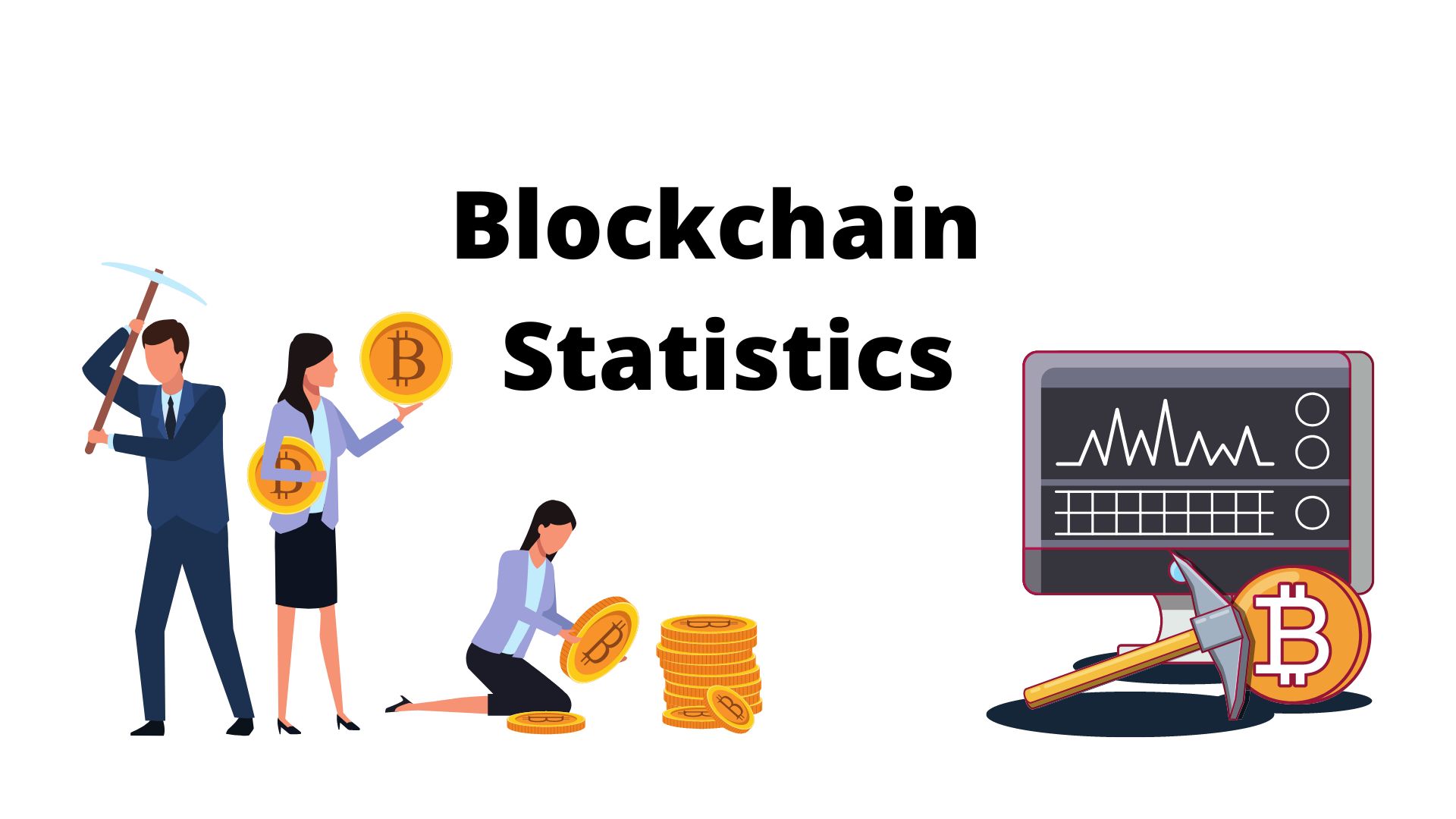
Page Contents
- Essential Blockchain Statistics
- Blockchain Market Outlook
- Blockchain Spending Worldwide
- Technology Application on Blockchain
- Trends of Blockchain
- Blockchain Technology Statistics Uses
- Blockchain Technology Statistics by Companies
- Cryptocurrency Statistics
- Blockchain Statistics for Business
- Blockchain Statistics by Demographics
- Statistics by Popularity
- Blockchain Benefits
- Concerns about Blockchain
- Blockchain's Other Uses Statistics
Essential Blockchain Statistics
- Blockchain Statistics: Blockchain technology is not yet mainstream, but many more businesses recognize its value for their businesses.
- Blockchain technology has been used by businesses to help them speed up digital processes.
- This technology is in an exciting phase. Dynamic data is generated in real time and presented time and again.
- You will learn the key statistics on the blockchain you should be paying attention to this year in this article.
- Very minute and keen observation of the industry can be obtained by looking at everything from market statistics for blockchain technology to individual use cases.
- These insights will allow you to decide if using the technology of blockchain is the right choice for your enterprise.
Blockchain Market Outlook
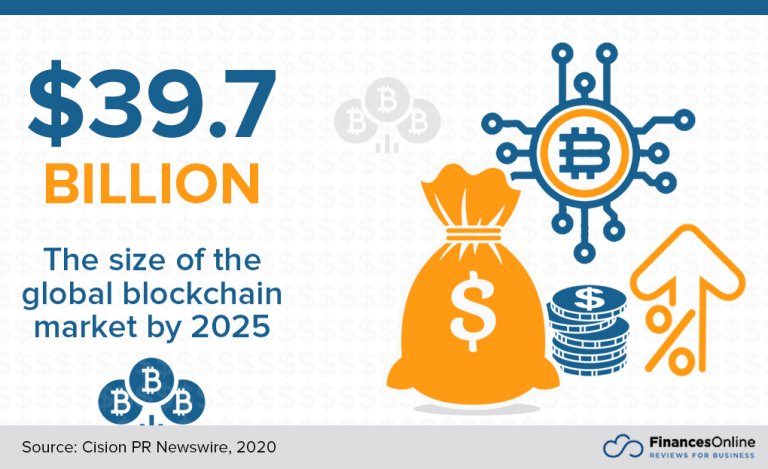 (Source: financesonline.com)
(Source: financesonline.com)
- The blockchain market has signs of promise. The global market of the blockchain industry is expected to reach $163.83 billion by the year 2029.
- As of 2023, around the world, there are more than 8,832 active cryptocurrencies available.
- By June 2023, each day’s Bitcoin transactions turned out 40.5 million which involved above 85 million Bitcoin block explorer blockchain.com wallet users across the world. This has led to Square and Bitcoin being the leaders in blockchain revenue and Ant Financial filing many active Blockchain patents.
- The United States was the biggest contributor to Blockchain spending. Western Europe came in second.
- The banking sector was the industry that spent the most on blockchain technologies.
- Blockchain Market Sizes and Revenue
- 46% was contributed by North America in the year twenty to the global market’s growth in blockchain technology. This was due to the adoption of blockchain solutions in government institutions, which contributed to growth in Canada as well as the US. (Source: Business Wire)
- Its market size is expected to increase up to 39.7 billion dollars from just three dollars by the year 2025. (Source: Cision PR Newswire)
- In the month of February, the revenue collected through Blockchain was 623.699. (Source: Blockchain.com).
- By the end of 2023, in the healthcare sector Blockchain technology has helped gain $231 million in revenue with a growth of 63%.
- On the other hand, global trading processing fees can be reduced up to $17-$24 billion by moving securities to blockchains.
- Every year financial institutions can save almost $12 billion by using Blockchain.
- Amazing figures showed with the spending figure on the worldwide front, it is estimated to be $17.9 billion by 2024. It will continue to grow annually at a compounded rate (CAGR of 46.4%). (Source: IDC)
- The top-notch expertise estimates that this technology will boost global GDP by 1.76 trillion by 2030 which amounts to 1.4% of global GDP (Source: Price Water house Coopers)
- By the end of 2026, the worth of the worldwide blockchain market is going to be $67.4 billion.
- As of June 2023, in every second there are 4.691 Bitcoin transactions.
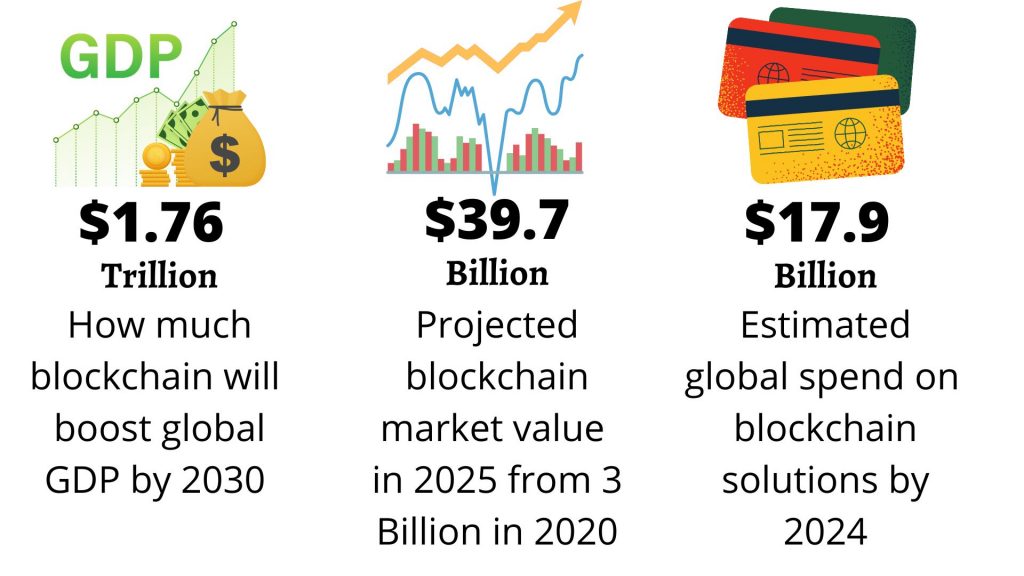
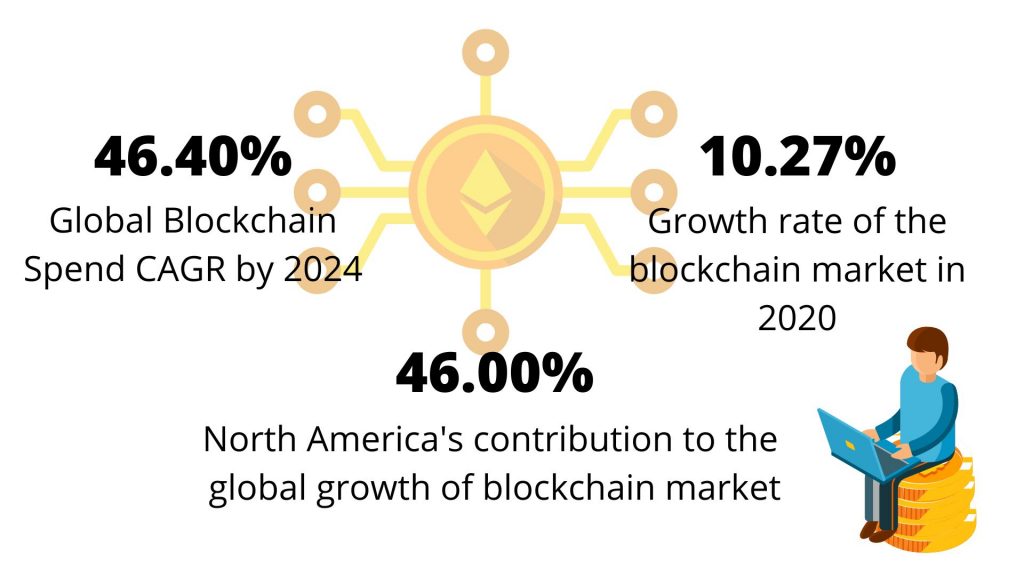
Blockchain Spending Worldwide
- The global blockchain technology industry is expected to grow by 85.9% of CAGR between the year 2022 to 2030.
- The highest distribution of blockchain market value is observed in the Banking sector with 29.7% market share in 2023.
- Furthermore, other sectors with blockchain technology statistics by market share are followed by Process manufacturing (11.4%), Discrete manufacturing (10.9%), Professional services (6.6%), Retail (6%), and others (35.3%).
- In 2023, blockchain will be used for cross-border payments and settlements.
- By the end of 2024, global spending on blockchain is going to reach $19 billion.
- In the year 2025, the healthcare sector's total cost of incorporating blockchain resulted in $5.61 billion.
- On the other hand, gaming industries with blockchain are expected to be $39.7 billion in 2025. Blockchain spending will grow at the fastest rate in the professional service industry, with a CAGR estimated at 54%.
- This is followed by 43.97% by healthcare and 48.2% respectively by state and federal government. (Source: IDC)
- The automotive industry will spend more on blockchain in 2019 than it did in 2019, at $849.5 million, and $14.731 billion in 2025. (Source: Cision PR Newswire)


Technology Application on Blockchain
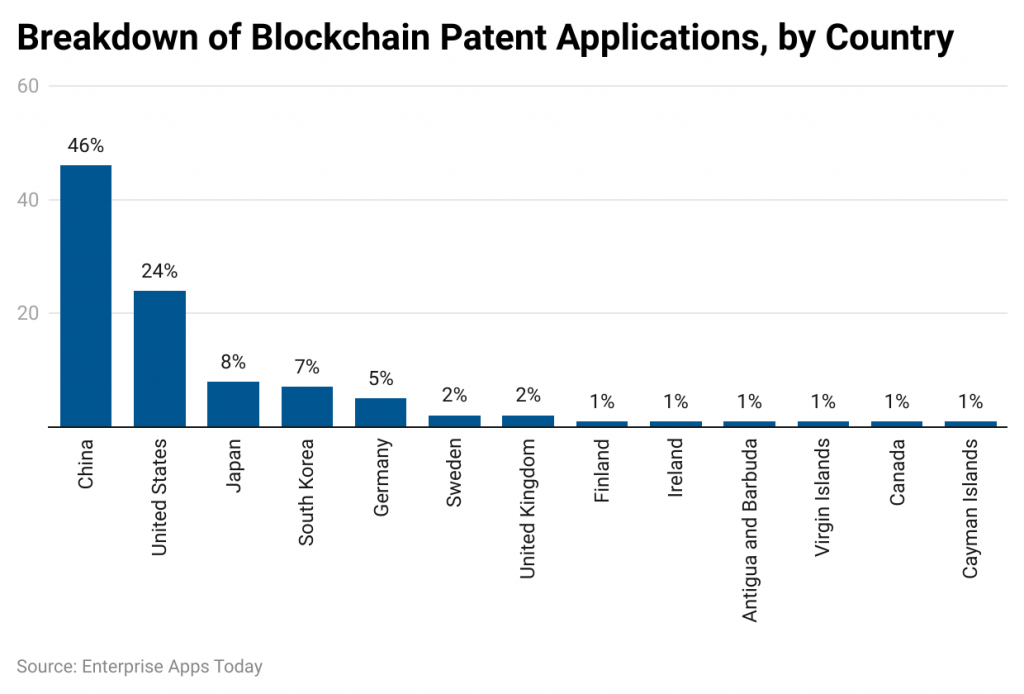 (Source: financesonline.com)
(Source: financesonline.com)
- While the market for the technology of blockchain is rapidly expanding, there are a variety of opinions within organizations on blockchain adoption. While the vast majority of senior executives believe that blockchain has the potential for wide-scale adoption, only about 40% admit to having adopted it within the company.
- A report on blockchain technology found that Blockchain adoption is highest in China. However, only half of IT leaders indicated that they did not want to adopt blockchain solutions.
- Data shows that the US has the highest number both of cryptocurrency ATMs and users of blockchain wallets when it comes to cryptocurrency. Based on transaction volume and value, Russia was ahead of Ukraine and Russia in cryptocurrency transactions.
- Blockchain Technology is being widely adopted.
- 88% think blockchain technology will be adopted mainstream by senior executives. (Source: Deloitte)
- A survey revealed that 39% of those surveyed said that blockchain technology was being used in their companies. 41% reported revenue greater than $100 million. 46% also had revenue over one billion dollars. (Source: Deloitte)
- In the real economy, more than 100 Chinese companies are linked with block applications.
- Whereas, in 2023 the blockchain market of South Korea is expected to be $356.2 billion.
- It has been experienced that by 2023 blockchain technology will become more eco-friendly.
- According to FinancesOnline.com by 2025, the market value of blockchain technology is expected to reach $39.7 billion.
- China is the strongest country for blockchain adoption. There, 70% of respondents said that blockchain was on their five top priority lists. It is only 42% that view it as a priority for organizations in Germany. (Source: Deloitte)
- Globally, currency in digital form (33% ), information to be accessed and shared (32%), or data reconciliation (31%) are the top uses of blockchain technology for organizations. Other top use cases for blockchain are the protection of identity (31%), payment (30%), and tracking & tracing (27%) (Source: Deloitte)
- Another study has shown that 36% of IT leaders are looking for blockchain security solutions. However, half of IT professionals were not interested in adopting blockchain security strategies. (Source: IDG)
- 40% of respondents stated that they intend to invest at least $5,000,000 in blockchain over the course of the next year. (Source: Deloitte)
- China is the country that will most benefit from blockchain technologies. China is projected to gain $440.4 million, or a 1.7% increase in its GDP in 2030. This is followed in the USA, where they expect a boost to four hundred 7.2 billion dollars. Germany at 95.3 billion dollars, and the UK, at 72.2 billion dollars. (Source: Price water house Coopers)
- Experts believe that blockchain technology will soon be used for 10 to 15% of the global infrastructure. (Source: Price water house Coopers)
- By 2030, blockchain will have 40 million new jobs. (Source: Price water house Coopers)
Trends of Blockchain
- Blockchain is expected to generate more than $3.1 trillion in commercial value by the end of 2030.
- Whereas, the worth of the Internet of Things (IoT) is expected to be $1,463.2 billion by 2027.
- In the healthcare industry, almost 55% of blockchain applications will be adopted by 2025.
- For accessing better business decisions and new markets integration of blockchain and AI helped effectively.
- In 2023, more than 20 countries have planned to raise the central bank's digital currencies.
- In January 2030, the worth of NFT has resulted in $946 million.
- Whereas, the credibility of Decentralized Autonomous Organizations has increased in April 2023 resulting in 12306 numbers of DAOs
Blockchain Technology Statistics Uses
- As of 2023, Digital currency is the main cause of using blockchain technology by 33%.
- Furthermore, other reasons for using blockchain technology are followed by Data access and sharing (32%), data reconciliation (31%), Identity protection (31%), Payments (30%), Track-and-trace (27%), Asset protection (27%), Asset transfer (25%), Certification (23%), and Record reconciliation (23%).
Blockchain Technology Statistics by Companies
- In 2023, the market size of the industrial blockchain is going to be $85.64 billion.
- According to a Forbes report, Ethereum is the blockchain network which is used in the Adobe Company in 2023.
- Whereas, the next top company used different blockchain networks used as Allianz (Hyperledger Fabric, Corda); and Andreessen Horowitz (Bitcoin, Ethereum, Solana, Flow, Celo, Near, Areave, and others).
- Other companies are followed by Ant Group (Antchain), Anthem (Hyperledger Fabric), Aon (Corda), A.P. Moller-Maersk (TradeLens, Hyperledger Fabric), Baidu (XuperChain), BHP (MineHub, Hyperledger Fabric), and Block (Bitcoin).
- In 2023, the global market value of blockchain in the financial sector is almost $3.07 billion.
- By the end of 2028, the global healthcare market size of blockchain turned $7.3 billion.
- Whereas in 2032 the global blockchain gaming market is expected to be $1,020 billion and by 2025 the global blockchain manufacturing market is going to be $5.6 billion.
Cryptocurrency Statistics
- As of 2023, the total crypto value received by the top region is North America with 35%.
- Other global regions receiving crypto values are followed by Europe (22%), Central and Southern Asia (13%), Eastern Asia (11%), Latin America (9%), Middle East (7%), and Africa (3%).
- To date, there are more than 22,900 cryptocurrencies and 8,832 active cryptocurrencies across the globe.
- In June 2023, the size of the Bitcoin blockchain is 464.83 Gigabytes, and by the end of the year mined Bitcoins will be near about 90%.
- As of 10th June 2023 reports, the price of Bitcoin is $25,658.
- Based on the trading volume Binance ($28.85 billion), HBTC $14.44 billion, and Hydax Exchange ($12.19 billion) are the top cryptocurrency exchanges. Dsdaq ($11.97 billion), ZG.com (11.5 billion), and Xheta Global (12.07 billion). (Source: Statista)
- With a market capitalization of 66%, Bitcoin was the market leader. Ripple (3%) and Ether (8%) were close behind. Litecoin’s market cap was 1%, while Monero’s was 0.5%. Other cryptocurrencies had a cumulative 7% market capitalization. (Source: Statista)
- By 2020, 63,000,000 com wallets will be online. The number of wallets that use the blockchain has increased steadily since 2015. (Source: Blockchain.com)
- The United States has the most ATMs (14,112 or 83%). Europe takes the second spot with 1,258 ATMs (7.4%), while Canada comes in third with two thousand forty-six ATMs (2.3%). (Coin ATM Radar.
- More than 1.193 million Ethereum transactions have been made every day since February 2021. (Source: Statista)
- According to the Global Crypto Adoption Index, Ukraine, Russia, China, Kenya, and South Africa were the top five countries. (Source: Chainalysis)
- In the year two thousand twenty-twenty, the country Ukraine sent 8.2 billion dollars and received 8.5 billion dollars in cryptocurrency. Russia received $16.6 billion of cryptocurrency and has sent more than $16.8 billion. One reason for high levels of cryptocurrency adoption in these nations is low public trust and confidence in government, businesses, and the media. (Source: Chainalysis)
- The total count of Bitcoin transactions stands at 272,006. Bitcoin also made around thirty-three thousand transactions in the year 2020, the month of December, and transactions of around four hundred thousand in 2021 the month of January. (Source: Statista)
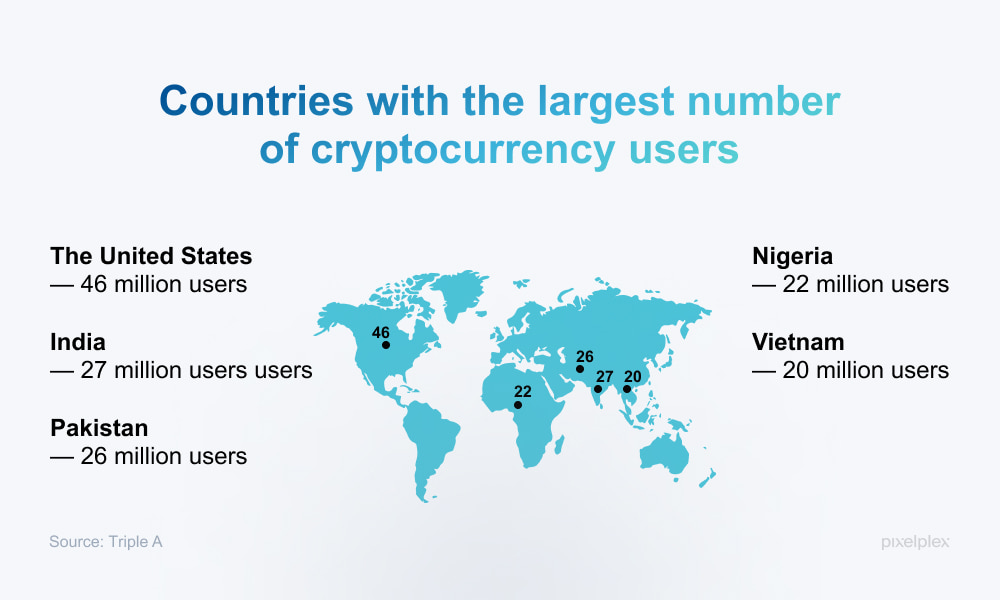 (Source: pixelplex.io)
(Source: pixelplex.io)
Blockchain Statistics for Business
- Organizations will use private blockchain models once they have decided to implement blockchain. The top use for blockchain is data provenance. This model is expected to bring followers of billions to the economy which is at the global level over the next ten years. However, current views are divided on the value and importance of the business of blockchain.
- Blockchain which is private is the most used model worldwide in organizations, representing 50% of all implemented models. Permissioned, private, and public blockchains follow at a 45% percentage of implementation globally. (Source: Statista)
- 55% of senior executives stated that Blockchain technology is a priority in their organizations. This number is 2% higher than the one in 2019. (Source: Deloitte)
- Experts in the UK logistics industry said that blockchain technology had “medium relevance”, while 23% said that it had “little relevancy” to them. (Source: Statista)
- The provenance of Data is the largest use case for the blockchain. This is when data can be recorded to prove the history. Its usage case is estimated that it will add $962 million to the global GDP for 2030. It is also impacted by identity ($224 billion), payment & financial ($433 billion), contract & resolution of disputes ($73 billion), customer involvement ($54 billion), and payment & financial ($433 billion). (Source: Price water house Coopers)
Blockchain Statistics by Demographics
- In 2023, investments in cryptocurrencies are 2 times more likely by males than females.
- The annual salary of 36% of blockchain users is almost more than $10 million in 2023.
- According to the survey reports of CNBC, in blockchain technology, the share of male investment is 16% and female investment is 7%.
Statistics by Popularity
- According to the reports of CoinMarketCap 2023, the most popular blockchain is Bitcoin with a $552.43 billion market share.
- Other blockchain's market capitalization is followed by Ethereum ($229.91 billion), BNB Chain ($49.44 billion), Cardano ($13.73 billion), and Doge ($1.26 billion).
- Whereas, total value locked statistics by the top 5 blockchains are followed by Ethereum ($54.81 billion), BNB Chain ($5.60 billion), Tron ($5.28 billion), Arbitrum ($2.47 billion), and Polygon ($1.39 billion).
Blockchain Benefits
Business leaders view blockchain as an enabling technological technology that will allow them to transform their businesses. More than 80% of respondents believe that blockchain will allow them the ability to integrate business processes seamlessly, increase business functionality, and comply with financial reporting regulations. Blockchain technologies have also brought about billions in cost savings for investment banks.
87% of global senior executives surveyed believed that blockchain will help them increase their integration towards the creation of touchless business processes.86% however believe that the blockchain will allow them to unlock new business functionality and revenue streams within their industry. (Source: Deloitte)
83% said that they are confident or “very” confident about fulfilling financial reporting requirements relating to blockchain. (Source: Deloitte)
Due to blockchain technologies, the world's biggest investment banks saw a 70% reduction in central finance reporting costs. They also indicated a 30%- 50% reduction in compliance costs, 50% savings on centralized operations, as well as 50% savings on business operations. (Source: Accenture)
Final note: The largest investment banks around the globe can save $ 12 billion annually by using technologies for blockchain. (Source: Accenture)
Concerns about Blockchain
Implementation is a major obstacle to the adoption of blockchain technology. This means that it requires replacing or adapting the existing legacy systems in an organization. There are concerns about cybersecurity, standardization, as well as interoperability. As blockchain mining consumes a lot of electricity, people who want to adopt it must take into account the impact on the environment.
According to senior executives, the main obstacles to blockchain implementation are regulatory issues (30%) as well as potential security threats (29%) Lack of in-house capability (28%), uncertain ROI (28%), or concerns about competitive information (25%) were some other reasons. (Source: Deloitte)
58% of companies state that cybersecurity is just one issue that they are considering when implementing blockchain technologies in their digital assets strategy. (Source: Deloitte)
More than 6,500 blockchain-related projects rely on mostly standalone solutions and blockchain platforms. It is difficult to standardize and integrate the many different blockchain networks. (Source: Finextra)
Blockchain miners consume 0.2% of total world electricity. This makes it extremely difficult for anyone wanting to adopt blockchain technologies. (Source: 101 Blockchains)
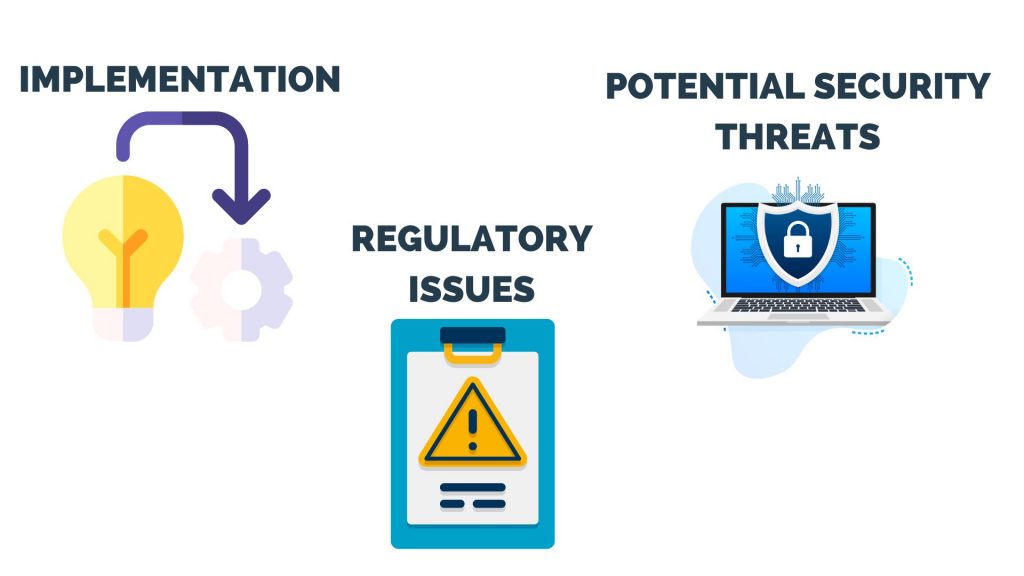
Blockchain's Other Uses Statistics
Blockchain technology has many interesting uses, beyond cryptocurrency. The technology of Blockchain uses it to authenticate luxurious goods and governments can monitor how many people have been vaccinated with COVID-19. Another emerging technology is non-fungible tokens. This allows for digital content ownership and exchange.
By 2026, the value of blockchain in agriculture and food is expected to be $1.48 billion.
In 2023, the blockchain used in the manufacturing industry helped in enhancing the market growth by $85.64 billion.
A survey on the basis of which it included 100 global companies that filed patent requests, across the world
The United States has the top blockchain funding companies resulting % in 2023.
The other funding blockchain companies statistics by countries are followed by China (18%), Switzerland (5%), United Kingdom (4%), and the rest of the world (22%).
A non-fungible token, a type de blockchain technology proving ownership of digital assets, was purchased at auction by Jack Dorsey and sold for $2.9 Million. (Source: CBS News)
The process of a Blockchain enables fashion brands to trace the source and track the supply chains. This prevents counterfeit luxury goods manufacturing that has already cost $4.5 trillion. (Source: Forbes)
New York has just implemented a COVID-19 COVID-19 passport. It's based in part on IBM, technology which is on heath pass and is digital. (Source: Forbes)
The blockchain industry is a fast-growing market and will soon generate billions in Blockchain revenue. These technologies are still being used in limited ways and new technologies are constantly improving their capabilities. It is safe to say that it will take many years for them to fully mature.
Business leaders' mixed reactions regarding the importance of blockchain technologies are one of the main obstacles to their adoption. No matter their stance on the topic, it's clear that there have been billions of cost savings for businesses by adopting blockchain technology. With a range of use cases that include financial applications, fashion, and healthcare, it is not surprising blockchain technology would be adopted well beyond the pandemic. While there are many benefits to blockchain technology, companies looking to adopt it need to take into account implementation challenges, cybersecurity concerns as well and environmental impacts when evaluating the options.
Sources
FAQ.
More than 68 million blockchain wallet users are active. While blockchain has many uses, cryptocurrencies still make up a large portion of the market. There were 68 million users of blockchain wallets as of 2021.
Since 2016, the individual use of blockchain technology has increased significantly. Statisticians in 2020 reported that there were over 40 million blockchain wallets by 2020, compared to 10 million in 2016.
There are 4 different types of blockchain networks available such as public blockchain, private blockcghain, hybrid blockchain, and Consortium blockchain with over 1 thousand blockchains globally.
As of June 2023, there are many popular blockchains are Bitcoin, Ethereum, Tether, BNB, USD, Avalanche, Cardano, and Polkadot.
Blockchain is a distributed digital ledger that allows peer-to-peer transactions to be time-stamped. Its applications are almost limitless. Data shows that blockchain technology has the potential to revolutionize business models, lending, security, and digital property. This is only a small part of the technology's wider capabilities.

Barry is a lover of everything technology. Figuring out how the software works and creating content to shed more light on the value it offers users is his favorite pastime. When not evaluating apps or programs, he's busy trying out new healthy recipes, doing yoga, meditating, or taking nature walks with his little one.

